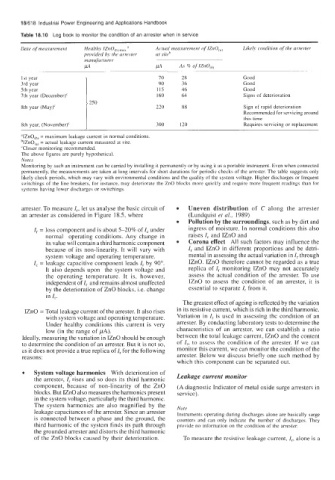Page 653 - Industrial Power Engineering and Applications Handbook
P. 653
18/618 Industrial Power Engineering and Applications Handbook
Table 18.10 Log book to monitor the condition of an arrester when in service
Date of measurement Health) IZnO(h, mdx' Actual nieasurement of IZn O,,, Likeh condition of the arrester
provided b, the arre\ter at siteh
manujacturer
PA PA AF R of IZnO,h,
~_____ ~~
1st year 70 28 Good
3rd year 90 36 Good
5th year 1 I5 46 Good
7th year (December)' I60 64 Signs of deterioration
250
8th year (May)' 220 88 Sign of rapid deterioration
Recommended for servicing around
this time
8th year, (November)' 300 I20 Requires servicing or replacement
"IZnOl,, = maximum leakage current in normal conditions.
bIZnOl,, = actual leakage current measured at site.
"Closer monitoring recommended.
The above figures are purely hypothetical.
Notes
Monitoring by such an instrument can be carried by installing it permanently or by using it as a portable instrument. Even when connected
permanently, the measurements are taken at long intervals for short durations for periodic checks of the arrester. The table suggests only
likely check periods, which may vary with environmental conditions and the quality of the system voltage. Higher discharges or frequent
switchings of the line breakers, for instance, may deteriorate the ZnO blocks more quickly and require more frequent readings than for
systems having lower discharges or switchings
arrester. To measure I,, let us analyse the basic circuit of Uneven distribution of C along the arrester
an arrester as considered in Figure 18.5, where (Lundquist et al., 1989)
Pollution by the surroundings, such as by dirt and
I, = loss component and is about 5-20% of I, under ingress of moisture. In normal conditions this also
normal operating conditions. Any change in raises I, and IZnO and
its value will contain a third harmonic component Corona effect All such factors may influence the
because of its non-linearity. It will vary with I, and IZnO in different proportions and be detri-
system voltage and operating temperature. mental in assessing the actual variation in I, through
I, = leakage capacitive component leads I, by 90". IZnO. IZnO therefore cannot be regarded as a true
It also depends upon the system voltage and replica of I, monitoring IZnO may not accurately
the operating temperature. It is, however, assess the actual condition of the arrester. To use
independent of I, and remains almost unaffected IZnO to assess the condition of an arrester, it is
by the deterioration of ZnO blocks, i.e. change essential to separate I, from it.
in I,.
The greatest effect of ageing is reflected by the variation
IZnO = Total leakage current of the arrester. It also rises in its resistive current, which is rich in the third harmonic.
with system voltage and operating temperature. Variation in I, is used in assessing the condition of an
Under healthy conditions this current is very arrester. By conducting laboratory tests to determine the
low (in the range of PA). characteristics of an arrester, we can establish a ratio
Ideally, measuring the variation in IZnO should be enough between the total leakage current, IZnO and the content
to determine the condition of an arrester. But it is not so, of I,, to assess the condition of the arrester. If we can
as it does not provide a true replica of I, for the following monitor this current, we can monitor the condition of the
reasons: arrester. Below we discuss briefly one such method by
which this component can be separated out.
System voltage harmonics With deterioration of Leakage current monitor
the arrester, I, rises and so does its third harmonic
component, because of non-linearity of the ZnO (A diagnostic Indicator of metal oxide surge arresters in
blocks. But IZnO also measures the harmonics present service).
in the system voltage, particularly the third harmonic.
The system harmonics are also magnified by the Note
leakage capacitances of the arrester. Since an arrester Instruments operating during discharges alone are basically surge
is connected between a phase and the ground, the counters and can only indicate the number of discharges. They
third harmonic of the system finds its path through provide no information on the condition of the arrester.
the grounded arrester and distorts the third harmonic
of the ZnO blocks caused by their deterioration. To measure the resistive leakage current, I,, alone is a

